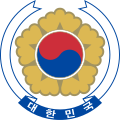October Restoration
This article needs additional citations for verification. (February 2022) |
| October Restoration | |
| Hangul | 10월 유신 |
|---|---|
| Hanja | 十月維新 |
| Revised Romanization | Siwol Yusin |
| McCune–Reischauer | Siwŏl Yusin |
The October Yusin (
Background
July 4 North–South Joint Declaration

On May 4, 1972, the director of
Third term of the presidency
Under the Third Republic's constitution, the president was limited to two terms in office. However, the National Assembly, dominated by Park's Democratic Republican Party, amended the Constitution in 1969 to allow a third term. He was re-elected in the 1971 presidential election.
1971 legislative election
The 8th general election was held on May 5, 1971. Park's Democratic Republican Party took 113 seats out of 204. However, it did not reach the minimum condition to pass a constitutional amendment, which required the concurrence of two thirds or more of the total members of the National Assembly. Therefore, Park could not amend the constitution through the lawful procedure.
Timeline
1969 referendum
In 1969, with a one-time amendment of the constitution, the incumbent president–Park–was allowed to run for a third consecutive term.
Declaration of a state of emergency
In December 1971, shortly after winning a third term, Park declared a state of emergency "based on the dangerous realities of the international situation".
Coup
This section needs expansion. You can help by adding to it. (March 2011) |
On October 17, 1972, Park dissolved the National Assembly, suspended the constitution and declared
The event was named after Japan's 1868 Meiji Restoration. Park Chung Hee, a former officer in the Japanese-controlled Manchukuo Imperial Army, admired Japanese politics, and called his self–coup Yusin (or Yushin), the Korean pronunciation of the Japanese word Ishin (restoration).
The new administration established after the coup is now called the Yusin Regime (유신체제, 維新體制) or Yusin Dictatorship (유신독재, 維新獨裁).
Constitution of the Fourth Republic
Under the Yusin regime, the Constitution of the Third Republic of Korea was replaced by the Yusin Constitution, the Constitution of the Fourth Republic.
In accordance with the Yusin Constitution, an electoral college called the National Council for Unification (통일주체국민회의, Tongil Juche Gungmin Hoeui) was set up. The conference elected the president and one-third of parliament. The presidential term was extended to six years, with no constitutional restrictions on the number of terms one could serve–effectively making Park president for life. It also allowed the president to declare "emergency measures" (긴급조치권, Gingeup Jochi), which allowed the president to promulgate laws without ratification by the National Assembly and suspend civil liberties.
In practice, the conference's power to appoint one-third of legislators was exercised by the president, guaranteeing him a parliamentary majority and control over parliament. Combined with his broad powers to rule by decree and curtail constitutional freedoms, the Yusin Constitution endowed the president with nearly all governing power in the nation.
Park justified his creation of a legal dictatorship by arguing that South Korea's economy was too weak to allow Western-style liberal democracy. Rather, he argued that the country needed a "Korean-style democracy" with a strong, unchallenged presidency in order to remain stable.[1]
Aftermath
The Yusin Regime was soon challenged by activists from groups such as college students, artists, religious leaders, and the opposition. Park suppressed these protests by force. In the People's Revolutionary Party Incident, eight persons were executed for treason. Their confessions, which were extracted by torture, were the only evidence and the executed are now generally considered to have been innocent. Despite this repression, the resistance to the Yusin Regime continued and caused serious social unrest.
The Yusin Regime was criticized internationally for
On October 26, 1979, the "10.26 Incident" occurred—the
Park's assassination removed the main impetus of the Yusin Regime. Although the military took power by consecutive coups (the
See also
- Bu-Ma Democratic Protests
- Enabling Act of 1933
- Proclamation No. 1081
- 2024 South Korean martial law
References
- ^ 주체사상과 한국적 민주주의는 왜 나왔을까 - 매일경제. Maeil Business Newspaper (in Korean). 14 November 2018. Retrieved 29 March 2019.


